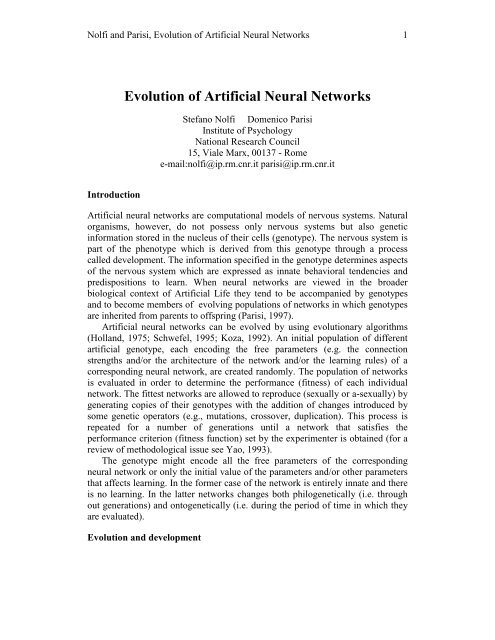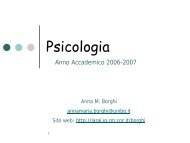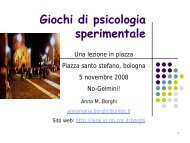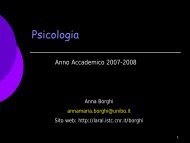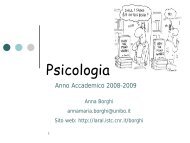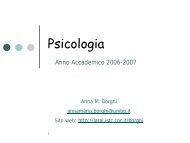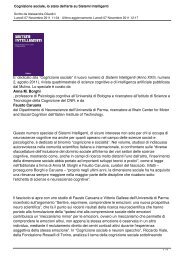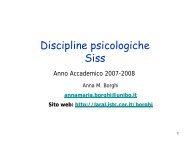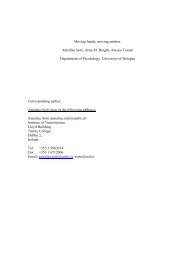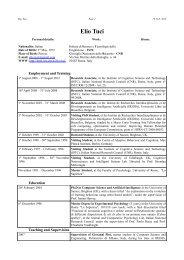Evolution of Artificial Neural Networks - laral
Evolution of Artificial Neural Networks - laral
Evolution of Artificial Neural Networks - laral
You also want an ePaper? Increase the reach of your titles
YUMPU automatically turns print PDFs into web optimized ePapers that Google loves.
Nolfi and Parisi, <strong>Evolution</strong> <strong>of</strong> <strong>Artificial</strong> <strong>Neural</strong> <strong>Networks</strong> 1<strong>Evolution</strong> <strong>of</strong> <strong>Artificial</strong> <strong>Neural</strong> <strong>Networks</strong>Stefano Nolfi Domenico ParisiInstitute <strong>of</strong> PsychologyNational Research Council15, Viale Marx, 00137 - Romee-mail:nolfi@ip.rm.cnr.it parisi@ip.rm.cnr.itIntroduction<strong>Artificial</strong> neural networks are computational models <strong>of</strong> nervous systems. Naturalorganisms, however, do not possess only nervous systems but also geneticinformation stored in the nucleus <strong>of</strong> their cells (genotype). The nervous system ispart <strong>of</strong> the phenotype which is derived from this genotype through a processcalled development. The information specified in the genotype determines aspects<strong>of</strong> the nervous system which are expressed as innate behavioral tendencies andpredispositions to learn. When neural networks are viewed in the broaderbiological context <strong>of</strong> <strong>Artificial</strong> Life they tend to be accompanied by genotypesand to become members <strong>of</strong> evolving populations <strong>of</strong> networks in which genotypesare inherited from parents to <strong>of</strong>fspring (Parisi, 1997).<strong>Artificial</strong> neural networks can be evolved by using evolutionary algorithms(Holland, 1975; Schwefel, 1995; Koza, 1992). An initial population <strong>of</strong> differentartificial genotype, each encoding the free parameters (e.g. the connectionstrengths and/or the architecture <strong>of</strong> the network and/or the learning rules) <strong>of</strong> acorresponding neural network, are created randomly. The population <strong>of</strong> networksis evaluated in order to determine the performance (fitness) <strong>of</strong> each individualnetwork. The fittest networks are allowed to reproduce (sexually or a-sexually) bygenerating copies <strong>of</strong> their genotypes with the addition <strong>of</strong> changes introduced bysome genetic operators (e.g., mutations, crossover, duplication). This process isrepeated for a number <strong>of</strong> generations until a network that satisfies theperformance criterion (fitness function) set by the experimenter is obtained (for areview <strong>of</strong> methodological issue see Yao, 1993).The genotype might encode all the free parameters <strong>of</strong> the correspondingneural network or only the initial value <strong>of</strong> the parameters and/or other parametersthat affects learning. In the former case <strong>of</strong> the network is entirely innate and thereis no learning. In the latter networks changes both philogenetically (i.e. throughout generations) and ontogenetically (i.e. during the period <strong>of</strong> time in which theyare evaluated).<strong>Evolution</strong> and development
Nolfi and Parisi, <strong>Evolution</strong> <strong>of</strong> <strong>Artificial</strong> <strong>Neural</strong> <strong>Networks</strong> 2A cornerstone <strong>of</strong> biology is the distinction between inherited genetic code(genotype) and the corresponding organism (phenotype). What is inherited fromthe parents is the genotype. The phenotype is the complete individual that isformed according to the instructions specified in the genotype.<strong>Evolution</strong> is critically dependent on the distinction between genotype andphenotype, and on their relation, i.e. the genotype-to-phenotype mapping. Thefitness <strong>of</strong> an individual, that affect selective reproduction, is based on thephenotype, but what is inherited is the genotype, not the phenotype. Furthermore,while the genotype <strong>of</strong> an individual is one single entity, the organism can beconsidered as a succession <strong>of</strong> different phenotypes taking form during thegenotype-to-phenotype mapping process, each derived from the previous oneunder genetic and environmental influences.When the genotype-to-phenotype mapping process takes place duringindividuals' lifetime we can talk <strong>of</strong> development. In this case, each successivephenotype, corresponding to a given stage <strong>of</strong> development, has a distinct fitness.The total fitness <strong>of</strong> a developing individual is a complex function <strong>of</strong> thesedevelopmental phases. <strong>Evolution</strong> must ensure that all these successive forms areviable and, at the same time, that they make a well-formed sequence where eachform leads to the next one until a mostly stable (adult) form is reached. This putsvarious constraints on evolution but it also <strong>of</strong>fers new means for exploringnovelty. Small changes in the developmental rates <strong>of</strong> different components <strong>of</strong> thephenotype, for example, can have huge effects on the resulting phenotype. Indeedit has been hypothesized that in natural evolution changes affecting regulatorygenes that control the rates <strong>of</strong> development played a more important role thanother forms <strong>of</strong> change such as point mutations (Gould, 1977).Although the role <strong>of</strong> the genotype-to-phenotype mapping and <strong>of</strong> developmenthas been ignored in most <strong>of</strong> the experiments involving artificial evolution, there isnow an increasing awareness <strong>of</strong> its importance. Wagner & Altenberg (1996)write: "In evolutionary computer science it was found that the Darwinian process<strong>of</strong> mutation, recombination and selection is not universally effective in improvingcomplex systems like computer programs or chip designs. For adaptation tooccur, these systems must possess evolvability, i.e. the ability <strong>of</strong> randomvariations to sometimes produce improvement. It was found that evolvabilitycritically depends on the way genetic variation maps onto phenotypic variation, anissue known as the representation problem." (p. 967).Genetic EncodingTo evolve neural networks one should decide how to encode the network in thegenotype in a manner suitable for the application <strong>of</strong> genetic operators. In most
Nolfi and Parisi, <strong>Evolution</strong> <strong>of</strong> <strong>Artificial</strong> <strong>Neural</strong> <strong>Networks</strong> 3cases, all phenotypical characteristics are coded in an uniform manner so that thedescription <strong>of</strong> an individual at the level <strong>of</strong> the genotype assumes the form <strong>of</strong> astring <strong>of</strong> identical elements (such as binary or floating point numbers). Thetransformation <strong>of</strong> the genotype into the phenotypical network is called genotypeto-phenotypemapping.In direct encoding schemes there is a one-to-one correspondence betweengenes and the phenotypical characters subjected to the evolutionary process (e.g.Miller et al., 1989). Aside from being biological implausible, simple one-to-onemappings has several drawbacks. One problem, for example, is scalability. Sincethe length <strong>of</strong> the genotype is proportional to the complexity <strong>of</strong> the correspondingphenotype, the space to be searched by the evolutionary process increasesexponentially with the size <strong>of</strong> the network (Kitano, 1990).Another problem <strong>of</strong> direct encoding schemes is the impossibility to encoderepeated structures (such as network composed <strong>of</strong> several sub-networks withsimilar local connectivity) in a compact way. In one-to-one mappings, in fact,elements that are repeated at the level <strong>of</strong> the phenotype must be repeated at thelevel <strong>of</strong> the genotype as well. This does not only affect the length <strong>of</strong> the genotypeand the corresponding search space, but also the evolvability <strong>of</strong> individuals. A fullgenetic specification <strong>of</strong> a phenotype with repeated structures, in fact, implies thatadaptive changes affecting repeated structures should be independentlyrediscovered through changes introduced by the genetic operators.Growing methodsThe genotype-to-phenotype process in nature is not only an abstract mapping <strong>of</strong>information from genotype to phenotype but it is also a process <strong>of</strong> physicalgrowth (growth in size and in physical structure). By taking inspiration frombiology therefore, one may decided to encode in the genotype growinginstructions. The phenotype is progressively built by executing the inheritedgrowing instructions.Nolfi et al. (1994) used a growing encoding scheme to evolve the architectureand the connection strenghts <strong>of</strong> neural networks that controlled a small mobilerobot (for a similar method see Husband et al., 1994). These controllers werecomposed <strong>of</strong> a collection <strong>of</strong> artificial neurons distributed over a 2-dimensionalspace with growing and branching axons (Figure 1, top). Inherited geneticmaterial specified instructions that controlled the axonal growth and the branchingprocess <strong>of</strong> neurons. During the growth process, when a growing axonal branch <strong>of</strong>a particular neuron reached another neuron a connection between the two neuronsis established. On the bottom <strong>of</strong> Figure 1 you can see the network resulting fromthe growth process displayed in the top <strong>of</strong> the Figure after the elimination <strong>of</strong>isolated and non-functional neurons. Axons grew and brunched only if the
Nolfi and Parisi, <strong>Evolution</strong> <strong>of</strong> <strong>Artificial</strong> <strong>Neural</strong> <strong>Networks</strong> 4activation variability <strong>of</strong> the corresponding neurons was larger than a geneticallyspecifiedthreshold. This simple mechanism is based on the idea that sensoryinformation coming from the environment has a critical role in the maturation <strong>of</strong>the connectivity <strong>of</strong> the biological nervous system and, more specifically, that thematuration process is sensitive to the activity <strong>of</strong> single neurons (see Purves,1994). Therefore the developmental process was influenced both by genetic andenvironmental factors (i.e. the actual sequence <strong>of</strong> sensory states experienced bythe network influenced the process <strong>of</strong> neural growth).Figure 1. Development <strong>of</strong> an evolved neural network. Top: The growing and branching process <strong>of</strong>the axons. Bottom: the resulting neural network after removal <strong>of</strong> nonconnecting branches and theelimination <strong>of</strong> isolated neurons and groups <strong>of</strong> interconnected neurons.
Nolfi and Parisi, <strong>Evolution</strong> <strong>of</strong> <strong>Artificial</strong> <strong>Neural</strong> <strong>Networks</strong> 5This method allows the evolutionary process to select neural networktopologies that are suited to the task chosen. Moreover, the developmentalprocess, by being sensitive to the environmental conditions, might display a form<strong>of</strong> plasticity. Indeed, as shown by the authors, if some aspects <strong>of</strong> the task areallowed to vary during the evolutionary process, evolved genotypes display anability to develop into different final phenotypical structures that are adapted tothe current conditions.Cellular EncodingsIn natural organisms the development <strong>of</strong> the nervous system begins with a foldingin <strong>of</strong> the ectodermic tissue which forms the neural crest. This structure givesorigin to the mature nervous system through three phases: the genesis andproliferation <strong>of</strong> different classes <strong>of</strong> neurons by cellular duplication anddifferentiation, the migration <strong>of</strong> the neurons toward their final destination, and thegrowth <strong>of</strong> neurites (axons, dendrites). The growing process described in theprevious section therefore characterizes very roughly only the last <strong>of</strong> these threephases. A number <strong>of</strong> attempts have been made to include other aspects <strong>of</strong> thisprocess in artificial evolutionary experiments.Cangelosi et al. (1994), for example, extended the model described in theprevious section by adding a cell division and migration stage to the alreadyexisting stage <strong>of</strong> axonal growth. The genotype, in this case, is a collection <strong>of</strong> rulesgoverning the process <strong>of</strong> cell division (a single cell is replaced by two "daughter"cells) and migration (the new cells can move in the 2D space). The genotype-tophenotypeprocess therefore starts with a single cell which, by undergoing anumber <strong>of</strong> duplication and migration processes, produces a collection <strong>of</strong> neuronsarranged in a 2D space. These neurons grow their axons and establish connectionuntil a neural controller is formed (for a related approaches see Dellaert and Beer,1994).Gruau (1994) proposed a genetic encoding scheme for neural networks basedon a cellular duplication and differentiation process. The genotype-to-phenotypemapping starts with a single cell that undergoes a number <strong>of</strong> duplication andtransformation processes ending up in a complete neural network. In this schemethe genotype is a collection <strong>of</strong> rules governing the process <strong>of</strong> cell divisions (asingle cell is replaced by two "daughter" cells) and transformations (newconnections can be added and the strengths <strong>of</strong> the connections departing from acell can be modified). In this model, therefore, connection links are establishedduring the cellular duplication process.The instructions contained in the genotype are represented as a binary-treestructure as in genetic programming (Koza, 1992). During the genotype-tophenotypemapping process, the genotype tree is scanned starting from the top
Nolfi and Parisi, <strong>Evolution</strong> <strong>of</strong> <strong>Artificial</strong> <strong>Neural</strong> <strong>Networks</strong> 6node <strong>of</strong> the tree and then following each ramification. The top node represents theinitial cell that, by undergoing a set <strong>of</strong> duplication processes, produces the finalneural network. Each node <strong>of</strong> the genotype tree encodes the operations that shouldbe applied to the corresponding cell and the two sub-trees <strong>of</strong> a node specify theoperations that should be applied to the two daughter cells. The neural network isprogressively built by following the tree and applying the correspondingduplication instructions. Terminal nodes <strong>of</strong> the tree (i.e. nodes that do not havesub-trees) represents terminal cells that will not undergo further duplications.Gruau also considered the case <strong>of</strong> genotypes formed by many trees where theterminal nodes <strong>of</strong> a tree may point to other trees. This mechanism allows thegenotype-to-phenotype process to produce repeated phenotypical structures (e.g.repeated neural sub-networks) by re-using the same genetic informations. Treesthat are pointed to more than once, in fact, will be executed more times. Thisencoding method has two advantages: (a) compact genotypes can producecomplex phenotypical networks, and (b) evolution may exploit phenotypes whererepeated sub-structures are encoded in a single part <strong>of</strong> the genotype. Since theidentification <strong>of</strong> sub-structures that are read more than once is an emergent result<strong>of</strong> the evolutionary process, Gruau defined this method Automatic Definition <strong>of</strong><strong>Neural</strong> Subnetworks (ADNS) (Gruau, 1994).Discussion<strong>Artificial</strong> evolution can be seen as a learning algorithm for training artificialneural networks. From this point <strong>of</strong> view, one distinctive feature is the limitedamount <strong>of</strong> feedback required. Supervised learning algorithms require immediateand detailed desired answers as a feedback. Reinforcement learning algorithmsrequire less - only a judgement <strong>of</strong> right or wrong which should not be necessarilyimmediate. Viewed as a learning algorithm, artificial evolution requires still less -only an overall evaluation <strong>of</strong> the performance <strong>of</strong> the network over the entireevaluation period. A second distinctive feature is that any parameter <strong>of</strong> the neuralnetwork (e.g. the connection strengths, the network topology, the learning rules,the transfer function <strong>of</strong> the neurons) can be subjected to the evolutionary process.Although systematic comparison between artificial evolution and otheralgorithms are not been done yet, it is reasonable to claim that artificial evolutiontend to produce better results when detailed feedback is not available. This is thecase, for example, <strong>of</strong> a neural networks that should control mobile robots (Nolfiand Floreano, 2000). In this case in fact, although the experimenter can provide ageneral evaluation <strong>of</strong> how much the behavior <strong>of</strong> a robot approximates the desiredbehavior, he or she cannot usually indicate what the robot should do each timestep to produce such a desired behavior. Moreover artificial evolution might resultmore effective in those cases in which certain features <strong>of</strong> the network (such as the
Nolfi and Parisi, <strong>Evolution</strong> <strong>of</strong> <strong>Artificial</strong> <strong>Neural</strong> <strong>Networks</strong> 7network topology or the transfer functions) that cannot be properly set by handare crucial. <strong>Artificial</strong> evolution, in fact, provide a way to co-adapt different type<strong>of</strong> parameters.The analogy with natural evolution however can also be considered morestrictly. In this case the evolutionary process is not seen as an abstract trainingalgorithm but as a process that mimics some <strong>of</strong> the key aspects <strong>of</strong> the evolutionaryprocess in nature. From this point <strong>of</strong> view neural networks tend to be viewed as apart <strong>of</strong> a population <strong>of</strong> artificial organisms that adapt autonomously by interactingwith the external environment.ReferencesCangelosi, A., S. Nolfi, and D. Parisi, 1994. Cell division and migration in a'genotype' for neural networks, Network- Computation in <strong>Neural</strong> Systems,5:497-515.Dellaert F. and R.D. Beer (1994). Toward an evolvable model <strong>of</strong> development forautonomous agent synthesis, in Proceedings <strong>of</strong> the Forth Conference on<strong>Artificial</strong> Life, (R. Brooks, and P. Maes, eds.), Cambridge, MA: MIT Press.Gould, S.J., 1977. Ontogeny and Phylogeny. Cambridge, MA: HarwardUniversity Press.Gruau F., 1994. Automatic definition <strong>of</strong> modular neural networks, AdaptiveBehavior, 3:151-183.Holland, J.J., 1975, Adaptation in natural and artificial systems. Ann Arbor, MI:University <strong>of</strong> Michigan Press.Husbands, P., I. Harvey, D. Cliff, and G. Miller, 1994. The use <strong>of</strong> geneticalgorithms for the development <strong>of</strong> sensorimotor control systems, in FromPerception to Action, (P. Gaussier, and J-D. Nicoud, eds.), Los Alamitos CA:IEEE Press.Kitano, H., 1990. Designing neural networks using genetic algorithms with graphgeneration system, Complex Systems, 4:461-476.Koza, J.R., 1992. Genetic Programming: On the Programming <strong>of</strong> Computers byMeans <strong>of</strong> Natural Selection, Cambridge, MA: MIT Press.Miller, G.F., P.M. Todd, and S.U. Hedge (1989). Designing neural networksusing genetic algorithms, in Proceedings Third International Conference onGenetic Algorithms, (L. Nadel, and D. Stein, eds.), San Mateo, CA: MorganKaufmann, pp. 379-384.Nolfi, S., and D. Floreano, 2000. <strong>Evolution</strong>ary Robotics: The Biology,Intelligence, and Technology <strong>of</strong> Self-Organizing Machines, Cambridge, MA:MIT Press/Bradford Books.Nolfi, S., O. Miglino, and D. Parisi, 1994. Phenotypic Plasticity in Evolving<strong>Neural</strong> <strong>Networks</strong>, in Proceedings <strong>of</strong> the Intl. Conf. From Perception to
Nolfi and Parisi, <strong>Evolution</strong> <strong>of</strong> <strong>Artificial</strong> <strong>Neural</strong> <strong>Networks</strong> 8Action, (D. P. Gaussier and J-D. Nicoud eds.), Los Alamitos, CA: IEEEPress, pp. 146-157.Parisi, D., 1997. <strong>Artificial</strong> life and higher level cognition, Brain and Cognition,34:160-184.Purves, D., 1994. <strong>Neural</strong> activity and the growth <strong>of</strong> the brain. Cambridge:Cambridge University Press.Schwefel, H.P., 1995. <strong>Evolution</strong> and Optimum Seeking, New York: Wiley Press.Yao, X., 1993. A review <strong>of</strong> evolutionary artificial neural networks, InternationalJournal <strong>of</strong> Intelligent Systems, 4:203-222.Wagner, G.P., and L. Altenberg, 1996. Complex adaptations and the evolution <strong>of</strong>evolvability, <strong>Evolution</strong>, 50:967-976.


